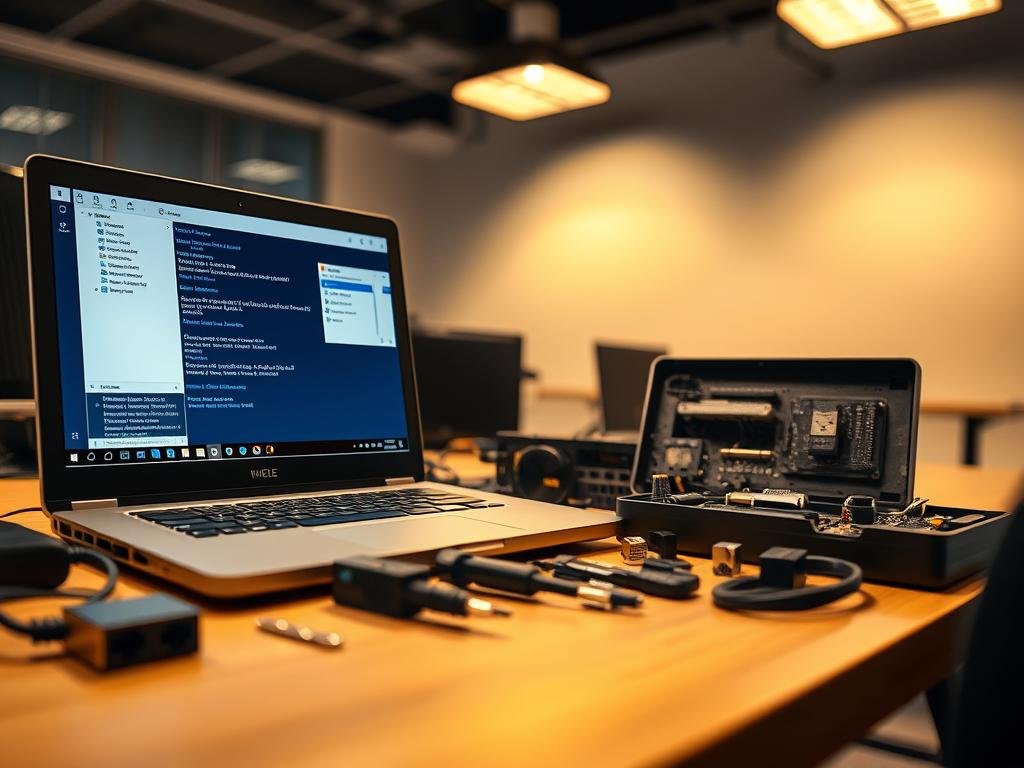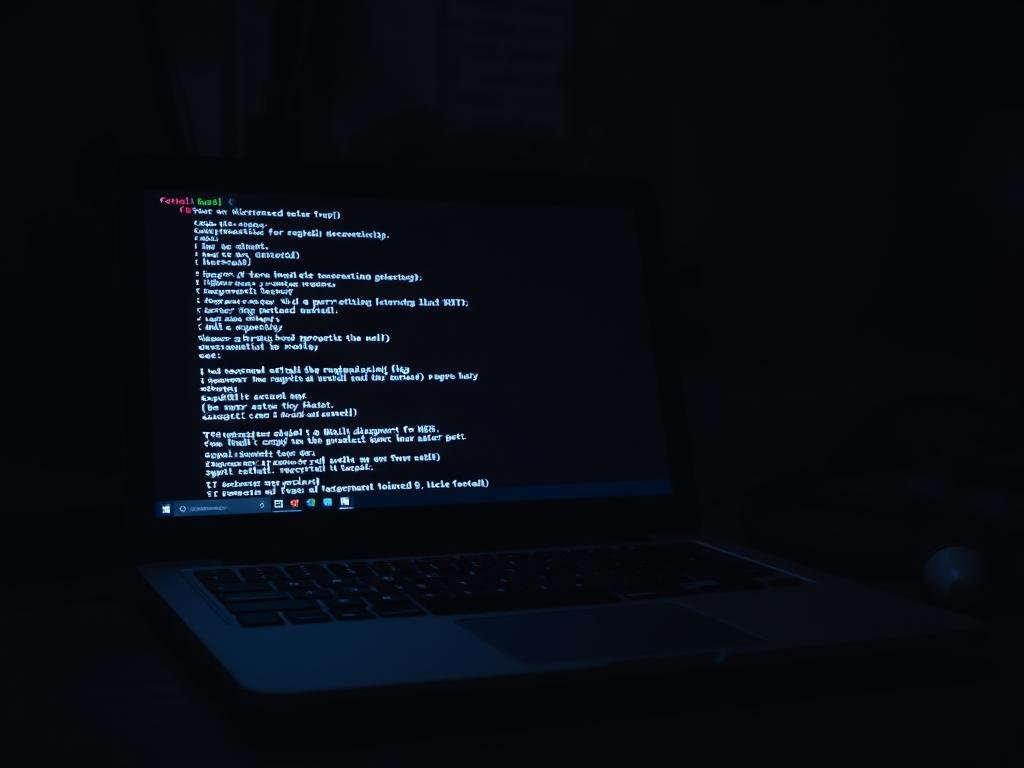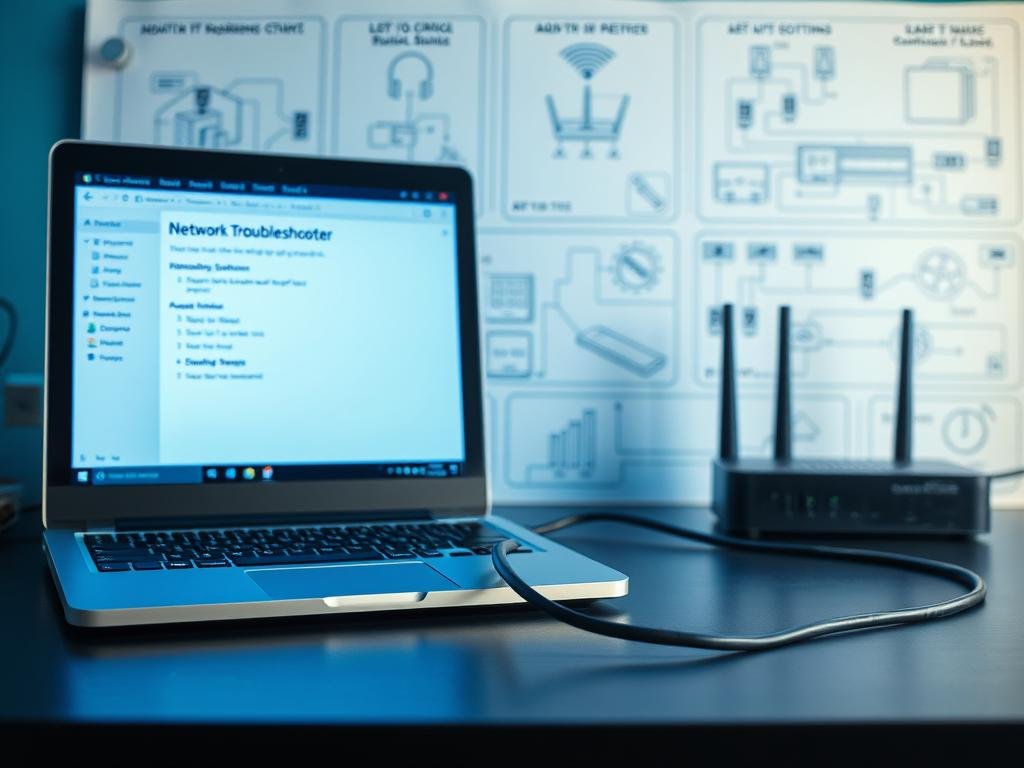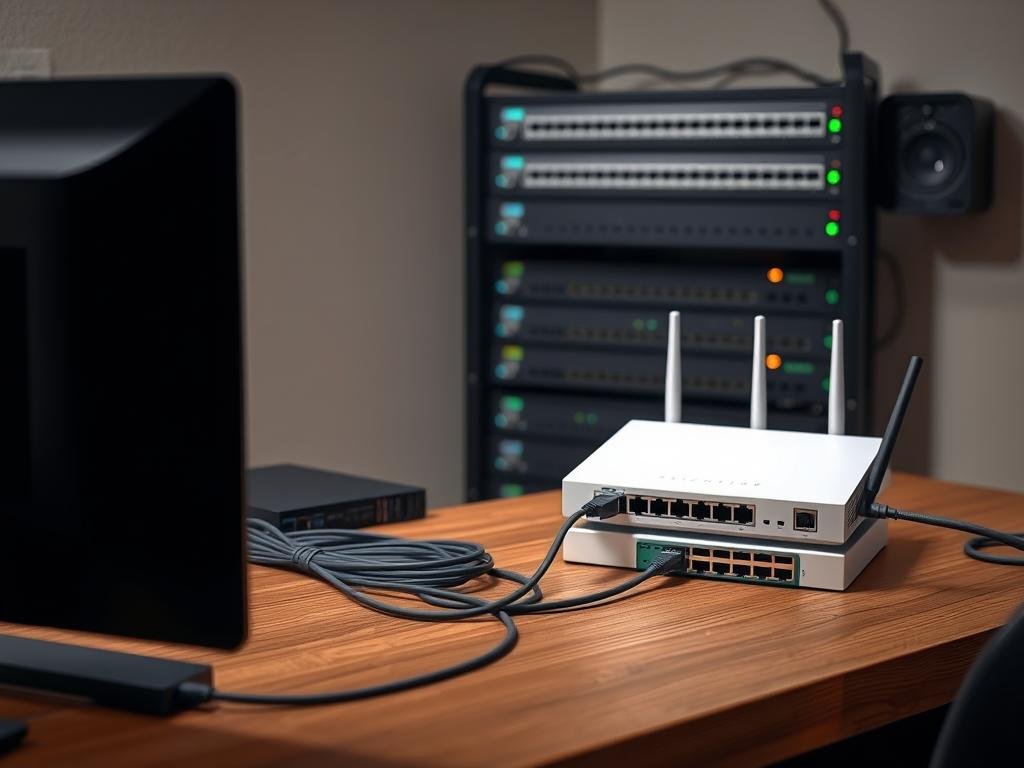A stable internet connection is key for many online activities. This includes work, entertainment, education, and communication. Yet, over 40% of households in the United States face internet connectivity issues each year. Ethernet connection problems are a big part of these issues.
If your PC’s Ethernet connection isn’t working right, you’re not alone. This article will help you fix common problems with your network setup. You’ll learn how to get a stable and reliable connection.
Key Takeaways
- Identify common causes of Ethernet connection problems
- Learn how to troubleshoot and resolve issues with your network setup
- Understand the importance of a stable internet connection for online activities
- Discover step-by-step instructions to fix Ethernet connection problems on PCs
- Improve your overall online experience with a reliable Ethernet connection
Understanding Ethernet Networks
To fix Ethernet problems, knowing how Ethernet networks work is key. Ethernet is a basic tech for local area networks (LANs) to link devices.
What is Ethernet?
Ethernet is a set of LAN protocols for devices to talk to each other over a cable. It’s a common tech for fast and reliable network connections. For more on Ethernet wiring, check out this resource.
How Ethernet Works
Ethernet sends data packets between devices on a network. This includes:
- Device identification using MAC addresses
- Data packet transmission over Ethernet cables
- Error detection and correction mechanisms
First, make sure your Ethernet cable is well plugged into both your router and PC. This keeps your connection stable.
Common Ethernet Network Configurations
Ethernet networks come in different setups, like:
- Star topology, where devices connect to a central hub or switch
- Bus topology, where devices are connected in a line
Knowing these setups helps you spot and fix network issues.
Learning about Ethernet networks helps you solve network problems better.
Identifying Ethernet Connection Issues
It’s key to spot Ethernet connection problems to get your internet back. Finding the cause can be tough, but knowing the signs helps. Basic fixes can often solve the problem.
Recognizing Symptoms of Problems
Ethernet issues show up in different ways. You might lose your internet, face frequent drops, or see slow speeds. If you notice these signs, it’s time to dig deeper.
Look out for these common signs:
- Can’t connect to the internet even with a physical link
- Connections keep dropping and coming back
- Speeds are much slower than what you’re used to
Let’s look at some possible causes and their signs in a table:
| Symptom | Possible Cause |
|---|---|
| No internet connection | Faulty Ethernet cable or loose connection |
| Frequent disconnections | Interference from other devices or network congestion |
| Slow data transfer | Outdated network drivers or incorrect network settings |

Basic Troubleshooting Steps
After spotting the symptoms, start basic troubleshooting. First, check your cables to make sure they’re plugged in right. Also, try restarting your router and computer.
Other steps include:
- Look for loose or damaged Ethernet cables
- Make sure your Ethernet drivers are current
- Check your network settings to make sure they’re right
By taking these steps, you can often fix common Ethernet problems. This will get your internet and data transfer working smoothly again.
Check Your Hardware Connections
The key to a good Ethernet connection is its hardware setup. You should start by checking if everything is connected right. This is important for keeping your network stable.
Inspecting Cables and Ports
First, look at your Ethernet cables for damage. Check for cuts, frays, or bent pins. These can mess up your connection. Also, check the Ethernet ports on your PC and router or modem for dust.
Use compressed air to clean out any dust. This helps make sure your connection is clear.
Testing for Loose Connections
Then, make sure all cables are plugged in tightly. A loose connection can cause network problems. To check, gently pull on the Ethernet cables at both ends.
If you find a loose connection, fix it. Then, see if your network issue gets fixed.
By carefully checking your hardware connections, you can fix many Ethernet problems. This is a key step in troubleshooting. It often solves connectivity issues quickly.
Updating Network Drivers
Keeping your network drivers updated is key to a stable wired network. Outdated drivers can cause connectivity problems, slow data transfer, and poor network performance.
Importance of Updated Drivers
Updated drivers make your Ethernet connection work better. They fix bugs, improve performance, and support new protocols. These are important for reliable network communication.
Key benefits of updating network drivers include:
- Improved network stability
- Enhanced data transfer speeds
- Better compatibility with the latest network protocols
- Fixes for known issues and bugs
How to Update Ethernet Drivers
Updating your Ethernet drivers is easy. Follow these steps to keep your drivers current:
- Identify your network adapter model
- Visit the manufacturer’s Support Downloads webpage
- Search for the latest driver software compatible with your operating system
- Download and install the updated driver
- Restart your PC to apply the changes
It’s recommended to download drivers directly from the manufacturer’s website to avoid potentially malicious software.
| Step | Description | Notes |
|---|---|---|
| 1 | Identify your network adapter model | Use Device Manager to find the model |
| 2 | Visit the manufacturer’s Support Downloads webpage | Look for the “Support” or “Downloads” section |
| 3 | Search for the latest driver software | Ensure compatibility with your OS |
| 4 | Download and install the updated driver | Follow the installation instructions |
| 5 | Restart your PC | To apply the changes |

Configuring Network Settings
Improving your Ethernet network settings can boost your PC’s data transfer speed. To do this, you need to access and tweak your network settings.
Accessing Network Settings on Your PC
To begin, you must access your PC’s network settings. Follow the steps on the Microsoft Support page. You’ll go to the Control Panel, then the Network and Sharing Center. There, you can see and change your network settings.
Adjusting Ethernet Properties
After getting to your network settings, tweak the Ethernet properties for better connection. You’ll adjust settings like IP address, subnet mask, and default gateway. For detailed help, check out Digital Vista Online for network setup guides.
Correctly adjusting Ethernet properties can make your network faster and more stable. Here are some key settings to tweak:
| Property | Description | Typical Setting |
|---|---|---|
| IP Address | Unique address for your device on the network | 192.168.1.x (x is a unique number for your device) |
| Subnet Mask | Defines the scope of the local network | 255.255.255.0 |
| Default Gateway | The IP address of your router | 192.168.1.1 (common for many routers) |
By fine-tuning these settings, you can improve your network’s performance and reliability. Keep in mind, the right settings depend on your network setup and needs.
Diagnosing with Command Prompt
Using the Command Prompt is a great way to find out why your Ethernet isn’t working. This tool comes with Windows and lets you run commands to fix internet and LAN problems.

Using Ping to Test Connectivity
The ping command is simple but very useful. Just type ping [IP address or website URL] in the Command Prompt. It checks if your PC can talk to a server or website.
For example, try ping www.example.com to see if your connection works. If it does, you’ll see how long it took for the signal to get there and back. But if you get a “Request timed out” message, it might mean there’s a problem with your internet or the server.
Tracing Routes for Deeper Analysis
The tracert command gives you more details. Type tracert [IP address or website URL] to see the path your connection takes. It shows where your connection might be failing, helping you find the issue.
Learning what these commands show can help you find the problem. It could be with your local network, router, or internet connection. Using these tools is a big step towards fixing your Ethernet issues.
Using Windows Network Troubleshooter
The Windows Network Troubleshooter is a great tool for finding and fixing Ethernet network problems. It helps when you have trouble connecting. This tool can find and fix issues, making your network work again.
Accessing the Troubleshooter
To use the Windows Network Troubleshooter, just follow these steps:
- Go to Settings on your Windows PC.
- Navigate to Update & Security.
- Select Troubleshoot from the left menu.
- Click on Additional troubleshooters.
- Choose Network Adapter and click Run the troubleshooter.
This will start a check on your network adapters, including Ethernet.
Interpreting Troubleshooting Results
After the troubleshooter finishes, it shows the results. You might see:
- Detected Issues: A description of any problems found.
- Recommended Actions: Steps to fix the issues.
Look over these results carefully. If it finds Ethernet network problems, follow the steps it suggests. These might include updating drivers or resetting network settings.

Using the Windows Network Troubleshooter can help find and fix Ethernet network problems. Running it often keeps your network healthy and stable.
Rebooting Your Router or Modem
If you’re having trouble with your Ethernet network, try rebooting your router or modem. This simple action can often fix connectivity problems and get your network working well again.
Steps to Safely Restart Your Devices
To reboot your router or modem, follow these steps carefully. This will help avoid any network setup issues. First, find your router and modem. These devices are key for your internet, and restarting them can refresh your network.
- Turn off your computer and any other devices connected to the network.
- Unplug the power cord from the back of your router and modem.
- Wait for about 30 seconds to allow any residual power to dissipate.
- Plug the power cord back into your modem and wait for it to boot up completely.
- Once your modem is online, plug the power cord back into your router and wait for it to boot up.
- Turn on your computer and other devices, and check if your Ethernet connection is working properly.
Importance of Network Device Reset
Resetting your network devices is key to fixing connectivity issues. Restarting your router or modem clears out any temporary problems or configuration issues. This can help re-establish a stable connection between your PC and the network.
Also, rebooting your network devices can apply recent firmware updates or changes in your network setup. It’s a simple yet effective way to troubleshoot and save time.
By following these steps, you can safely restart your router or modem. This might solve your Ethernet network problems. If issues continue, you may need to try other troubleshooting options.
Setting Static IP Addresses
A static IP address is key for steady network communication on your PC. It makes sure your device always has the same IP address. This makes managing network connections and remote access easier.
Benefits of a Static IP Configuration
Having a static IP for your PC brings many benefits, mainly in wired networks. It gives your device a fixed identity on the network. This makes remote access, network troubleshooting, and hosting services simpler.
- Easier remote access to your PC
- Simplified network troubleshooting
- Consistent hosting of network services
How to Set a Static IP on Windows
To set a static IP on your Windows PC, just follow these steps:
- Open the Control Panel and go to “Network and Sharing Center.”
- Click on “Change adapter settings” and pick your Ethernet connection.
- Right-click on “Ethernet” and choose “Properties.”
- Select “Internet Protocol Version 4 (TCP/IPv4)” and click “Properties.”
- Choose “Use the following IP address” and enter your desired IP address, subnet mask, and default gateway.
For more detailed instructions and troubleshooting tips, check out Netgear’s guide on setting a static IP.
By following these steps, you can set up a static IP on your Windows PC. This will improve your wired network experience.
Checking for Firewall or Antivirus Conflicts
Firewall and antivirus programs keep your computer safe. But, they can sometimes block your network connection. It’s important to make sure they’re not stopping your internet access.
Identifying Possible Blockages
First, look for signs that your security software might be the problem. If you can’t connect to the internet, or if your network is slow, it could be a sign. Check your security software settings to see if it’s blocking what you need.
Looking at your security software’s logs can help. It might show if it’s blocking your internet connectivity. Look for any alerts about blocked connections or suspicious activity.
Configuring Exceptions in Security Software
If you think your security software is the issue, you can make changes. You can tell your firewall or antivirus to let your network connection work. This means adding the program or service to your trusted list.
- For firewalls, you create a rule for incoming or outgoing connections for a specific app or port.
- For antivirus, you add the app to an exclusion list so it’s not scanned or blocked.
By adjusting your security settings, you can often fix problems with your network connection. This will help you get back to stable internet connectivity.
Resolving DNS Issues
It’s key to know how to fix DNS problems for a stable network. DNS, or Domain Name System, is important. It changes domain names into IP addresses that computers can get.
Understanding the Role of DNS
DNS is like the internet’s phonebook. It lets us use easy domain names instead of hard IP addresses. When you enter a URL, DNS servers find the IP address for you.
Common DNS Issues include DNS not working, slow lookups, and servers not being found. These can happen for many reasons like wrong DNS settings or server overload.
Changing DNS Servers
Changing your DNS servers can help fix problems. You can use public DNS services like Google DNS or Cloudflare DNS. They might work better and be safer.
To change DNS on a Windows PC, do this:
- Go to your Network and Sharing Center.
- Click on “Change adapter settings.”
- Right-click on your Ethernet connection and select “Properties.”
- Select “Internet Protocol Version 4 (TCP/IPv4)” and click “Properties.”
- Choose “Use the following DNS server addresses” and enter your preferred DNS server addresses.
For more help on fixing Ethernet problems, including DNS issues, check Microsoft’s support page.
Experts say flushing the DNS cache can solve DNS problems. This action depends on your operating system. It’s usually done through the command prompt or terminal.
“The DNS is a critical component of the internet infrastructure, and understanding how to manage and troubleshoot it is vital for network administrators and users alike.”
When to Seek Professional Help
If you’ve tried everything and your Ethernet network isn’t working, it’s time to get help. Issues like broken network hardware or interference need a pro to fix.
Signs You Need Expert Assistance
Signs you need a pro include constant connection problems, slow data, and trouble staying connected. If you’re facing these, a pro can find and fix the problem.
How to Find a Reliable Technician
To find a good technician, look for certified ones with Ethernet experience. Check online reviews, ask friends, or contact a trusted IT service. For more on Ethernet cable issues, visit Linden Photonics’ guide.
Getting professional help ensures your Ethernet network works right. It saves you time and reduces stress.
FAQ
What is Ethernet and how does it work?
Ethernet is a way to connect devices to a network using cables. It sends data packets between devices. This lets them communicate and share data.
How do I identify Ethernet connection issues on my PC?
Look for signs like disconnections, slow speeds, or not connecting. Start by checking cables and updating drivers. Then, adjust your network settings.
Why is it important to check hardware connections when troubleshooting Ethernet issues?
Loose or damaged cables and ports can cause problems. Check for damage or dust. Make sure connections are tight.
How do I update my Ethernet drivers to ensure optimal network communication?
Use the Device Manager to find and install new drivers. Keeping drivers up-to-date helps your network work better.
Can I use the Command Prompt to diagnose Ethernet issues?
Yes, the Command Prompt can help. Use commands like ping to check connections. It can also trace routes to find network problems.
How do I access and configure network settings on my PC?
Go to the Control Panel or Settings app. Adjust Ethernet properties to improve your connection and data transfer.
What is the purpose of the Windows Network Troubleshooter?
It’s a tool to find and fix network problems. It can identify issues and suggest solutions.
Why is rebooting my router or modem sometimes necessary?
It resets devices and clears glitches. It’s a simple fix for many Ethernet problems.
How do I set a static IP address on my Windows PC?
Go to Network and Sharing Center. Change adapter settings. Enter IP address, subnet mask, and default gateway manually.
Can firewall or antivirus software block my Ethernet connection?
Yes, they can if set to block. Check your security software to make sure it’s not blocking your network.
What is DNS, and how can I resolve DNS issues?
DNS translates domain names to IP addresses. Try changing DNS servers to Google Public DNS or Cloudflare DNS to fix issues.
When should I seek professional help for my Ethernet network problems?
If troubleshooting doesn’t work, or if you’re unsure about network settings, seek help. Professionals can solve complex problems.
